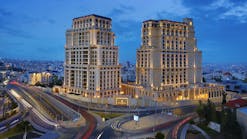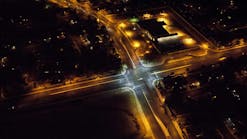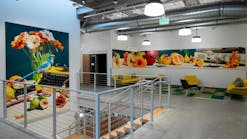Philips Lighting and the US Department of Energy (DOE) have jointly presented a webcast on the LED lamp that won the L-Prize competition to find a replacement for 60W incandescent lamps. Philips is assembling production versions of the solid-state lighting (SSL) retrofit lamp in the US, and plans to ship them into distribution in February. The company has set a $50 retail price, although utility incentives will reduce that cost in many cases.
The new lamp, primarily targeting commercial lighting applications, will deliver 940 lm and Philips is specifying an L70 life of 30,000 hours. The official model number is 10A19/LPRIZE-PRO/2700-900 DIM 10/1. Distributors will get the lamp in early February, and retailers should have the product in stock shortly thereafter.
The DOE announced Philips as the winner of the 60W L Prize back in August. One of the requirements was a manufacturing plan for a candidate lamp. We will see that plan come to fruition in weeks.
The webinar entitled "L-Prize-winning LED A19 replacement: What commercial building owners/operators can expect in 2012" was held January 18 and allowed the DOE and Philips to answer questions about the L-Prize program and the winning lamp. Speakers included Kelly Gordon, program manager at the DOE's Pacific Northwest National Laboratory (PNNL), and Todd Manegold, director of LED lamps and marketing North America at Philips Lighting.
Workhorse 60W
Gordon covered the rationale behind the 60W incandescent as the target of the program, and the process that ultimately yielded the Philips lamp as the winner. Gordon said there are 971 million 60W A-lamps in the US, including broad commercial usage in hotel, restaurant, retail, medial, and other applications. Clearly there is great potential for saving energy with a more efficient lamp.
You can clearly see that the L-Prize lamp is top in terms of efficacy and among the brightest LED lamps. Indeed the design delivers light output closer to what's expected from a 75W incandescent. The L-Prize lamp also got top ratings in CRI and color-temperature comparisons relative to the incandescent standard.
Gordon noted that the L-Prize requirements were far more strenuous than Energy Star requirements, and that most available LED retrofit lamps fail to meet Energy Star. She said there are less than 20 LED A-lamps certified to Energy Star and less than half of those are targeted at 60W sockets.
Energy Star status
Manegold was asked about the Energy Star status of the L-Prize lamp. He said, "The product will have Energy Star status in the 2nd quarter," adding that testing is underway. Moreover, Philips has achieved Energy Star compliance with other LED lamps based on a design that was derived from the L-Prize work.
Energy Star specifies that 60W replacement lamps deliver 800 lm at 50-55 lm/W efficacy depending on power consumption. The preproduction L-Prize lamps that the DOE tested delivered just over 900 lm, and greater than 90 lm/W efficacy.
Gordon also detailed how the DOE tested the 2000 sample lamps that Philips manufactured for the L-Prize program. The DOE verified Philips' photometric data, but the more important tests came in long-term lab testing, stress testing and field testing.
When the DOE awarded Philips the L Prize, the agency had burned 200 of the lamps continuously for 7,000 hours at an elevated temperature of 45
Stress tests
Stress tests included exposure to temperature extremes, vibration, and dirty power input. No LED lamps failed. Meanwhile, the DOE put a sample of what it considered high-quality compact fluorescent (CFL) lamps through the same test concurrently with the LED lamps, and every tested CFL failed.
Moving to the field testing, Gordon said, "Those field assessments were completed in the summer and fall of 2010." Testing included quantitative measurement of installed lamps in applications, and subjective review by test subjects.
Manegold summarized a few of the field tests, yielding some interesting facts. In a hotel downlight application, the sub-10W LED lamp was used in place of a 67W incandescent lamp in a 24-hour operational scenario. Accounting for a 55-lamp project, the LEDs delivered annual energy savings of $2,784. In fact that figure covers the higher up-front cost of the LEDs, delivering a quick payback of slightly less than a year.
Essentially the same test was repeated with 32W CFL lamps. The savings aren't as significant, but payback is still 2.3 years.
Chicago Merchandise Mart
In a test at the Chicago Merchandise Mart, the L-Prize lamps were used to replace 60W incandescent lamps in ceiling-mounted fixtures (Fig.2). Each fixture uses 9 lamps. The LEDs delivered payback in 1.59 years.
It turns out, however, that the LED-equipped fixtures were far brighter than the incandescent-lit fixtures. Five LED lamps would deliver equivalent performance to nine incandescent lamps. Manegold said, "They were still able to deliver what people judged to be just the right amount of light." Repeating the comparison with 5-lamp LED installations, the testers found that SSL would yield payback in 0.81 years.
The Q&A session following the webinar yielded a few other interesting observations. One viewer questioned why the DOE is conducting the long-term, lumen- and color-maintenance tests at higher than room temperature (25°C). Gordon said that some applications with restricted air flow such as downlights would put the lamps in elevated temperature environments, and that led to the testing at 45°C.
Evidently a number of people asked whether any consideration was given to the fact that the unlit Philips lamps appear yellow due to the use of remote-phosphor technology. Gordon simply indicated that the lamps met the L-Prize requirements. Philips has used product labeling on other remote-phosphor lamps that inform the consumer that the light is white when powered on, and Manegold said that practice would continue with the L-Prize lamps. But Manegold said, "The best way to demonstrate the product is when it is on."
There were also questions about the fact that the tested samples were different from the lamp Philips will put into production. The production lamp has three rather than four optical segments that illuminate and uses fewer LEDs. Gordon and Manegold attributed those changes to the continuing improvement of LED technology.
Manegold noted that the production product is brighter at 940 lm than the tested lamp that was just over 900 lm. He said, "It has 17% more light than other 60W replacement lamps on the market. It's a product that delivers high quality light without compromise."
There was the inevitable question about other entries to the L-Prize competition, although as we documented in September, the DOE had called that contest over, despite having originally said that more than one entrant could receive recognition in the 60W category.
Gordon seemed to leave the door cracked for future contest under the L-Prize program. Back in September it appeared that the planned PAR38 and 21st century lamp categories would be scrapped. But Gordon said, "There may be future categories in the L-Prize contest."









